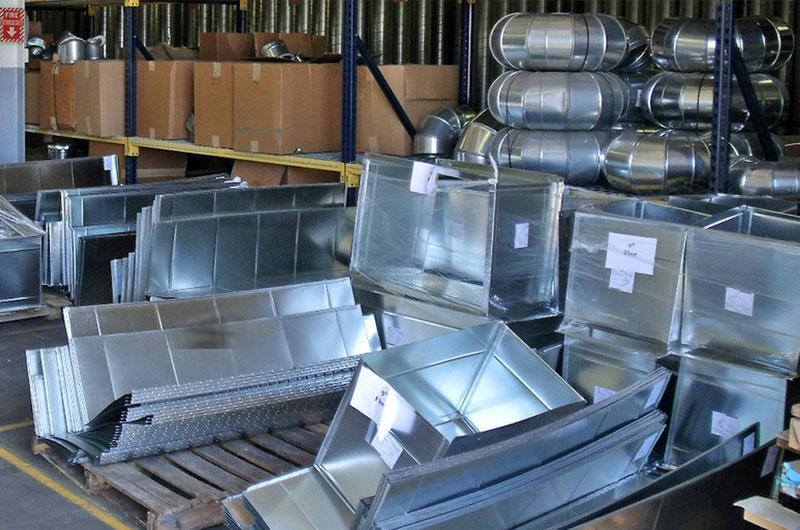Heating, Ventilation, and Air Conditioning (HVAC) systems are integral to indoor environmental control, and at the heart of every efficient HVAC system lies precision-engineered ductwork. Sheet metal cutting is a foundational step in the HVAC ductwork fabrication, influencing airflow efficiency, assembly speed, structural integrity, and overall cost.
This article explores the key cutting methods, material considerations, and best practices involved in sheet metal cutting for HVAC ductwork production.
Why Sheet Metal Cutting Matters in HVAC Ductwork
HVAC ducts are typically fabricated from galvanized steel, aluminum, or stainless steel sheets. These metal sheets must be cut with high accuracy to:
- Ensure proper air sealing and connection fit
- Minimize pressure loss and turbulence
- Allow for faster on-site installation
- Reduce waste and optimize material usage
- Maintain structural rigidity and durability
A precise cut ensures that each duct section, elbow, transition, or plenum fits seamlessly with others, avoiding costly errors and airflow inefficiencies.
Common Sheet Metal Materials for HVAC Ducts
The choice of material affects the cutting method, tooling, and handling:
| Material | Properties | Use in HVAC Ductwork |
|---|---|---|
| Galvanized Steel | Durable, corrosion-resistant, cost-effective | Most common for residential and commercial systems |
| Aluminum | Lightweight, corrosion-resistant | Ideal for coastal areas and low-weight installations |
| Stainless Steel | Highly durable, heat and corrosion resistant | Used in specialized or industrial environments |
Key Cutting Methods for HVAC Ductwork
Laser Cutting
Laser cutting directs a concentrated beam of light to melt or vaporize sheet metal with precision. It provides extremely high precision, tight tolerances, and clean edges.
Pros:
- Ideal for complex geometries and custom duct shapes
- Minimal burrs and post-processing
- High automation compatibility for mass production
Cons:
- Higher initial equipment cost
- Not cost-effective for low-volume runs
Plasma Cutting
Plasma cutting employs a high-speed stream of ionized gas to slice through electrically conductive materials.
Pros:
- Fast for medium-to-thick materials
- Suitable for cutting galvanized steel
- Moderate equipment costs
Cons:
- Less precise than laser
- Some edge cleanup may be needed
Waterjet Cutting
This method uses high-pressure water, often with an abrasive, to cut a variety of metals without generating heat.
Pros:
- No heat-affected zones (ideal for materials sensitive to heat)
- Can cut thick or laminated sheets
Cons:
- Slower than laser or plasma
- More expensive for high-volume work
Shearing (Mechanical Cutting)
A mechanical cutting method involving straight-line cuts using a shear or guillotine.
Pros:
- Fast and cost-effective for straight cuts
- Excellent for rectangular duct sections
Cons:
- Not suitable for curves or complex shapes
CNC Punching
CNC turret punching uses tools to stamp or punch out shapes in sheet metal.
Pros:
- Efficient for repeated cut patterns (e.g., bolt holes, cutouts)
- Integrates well with forming and bending processes
Cons:
- Limited flexibility for intricate designs
- Requires different dies for each hole shape or size
Cutting Considerations in Ductwork Production
1. Precision and Tolerances
Tight tolerances are crucial for duct fittings, especially in modular HVAC systems. Even small deviations can cause airflow inefficiencies or require rework.
2. Material Thickness
Most HVAC ducts use sheet metal between 26 to 16 gauge (0.018 to 0.059 inches). Thicker materials require more powerful cutting methods (e.g., plasma), while thinner sheets benefit from laser or shearing.
3. Edge Quality
Smooth, burr-free edges enhance safety during handling and ensure better alignment in assembly. Laser and waterjet cuts typically offer the best edge quality.
4. Automation and Production Volume
For high-volume duct production, integrating cutting systems into CNC fabrication lines enables consistent output, automatic nesting for minimal waste, and faster turnaround.
Best Practices in Sheet Metal Cutting for HVAC
- Implement nesting software to optimize material layout and minimize waste.
- Invest in proper ventilation and filtration systems for plasma or laser cutting setups to handle fumes and particulates.
- Pair cutting systems with CNC bending machines for a seamless transition between cutting and forming operations.
- Implement quality control checkpoints after cutting to catch errors early.
- Regular maintenance of cutting tools and calibration of equipment ensures consistent performance.
Innovations in Duct Cutting Technology
Modern HVAC manufacturing is increasingly adopting automation, AI-driven nesting algorithms, and integrated CAD/CAM systems. These innovations allow for:
- Customization of duct sections based on building plans
- Real-time design adjustments
- Rapid prototyping of new duct shapes
- Full traceability of components in mass production

